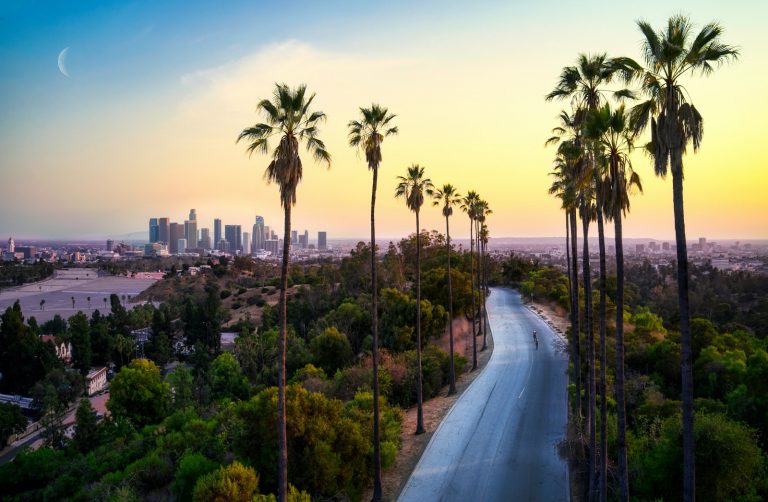Los Angeles, the bustling heart of Southern California, encapsulates a city of contrasts, where glitzy Hollywood meets gritty realities, and sprawling urban landscapes stand in stark juxtaposition to vibrant cultural enclaves. Amidst the city’s ceaseless energy and iconic landmarks, it grapples with complex urban challenges, and some of the most glaring issues often converge at its intersections.
Beyond the congested roadways and vehicular hazards, these intersections have garnered notoriety for a different set of perils, including rising crime rates and the visible struggles of the homeless population. In this comprehensive article, we embark on a journey through the tumultuous crossroads of Los Angeles, shedding light on the ten most dangerous intersections in the city.
Our exploration will encompass a multifaceted perspective, dissecting these perilous junctures from angles encompassing crime, homelessness, and motor vehicle-related concerns. Understanding the intricate web of challenges that these intersections embody is not just a matter of curiosity but a crucial endeavor for the well-being and safety of the city’s residents, daily commuters, and the tireless urban planners striving to enrich the quality of life in this iconic metropolis.
These intersections are not just physical meeting points of roads but represent critical intersections of public discourse and civic action. They encapsulate the intricate tapestry of Los Angeles, where the glamor of the entertainment industry stands in contrast to the harsh realities faced by marginalized communities. The challenges faced by these intersections mirror the broader challenges faced by the city itself – a city that grapples with issues of income inequality, housing insecurity, and access to healthcare. By delving into the unique complexities of these intersections, we embark on a journey to uncover the underlying societal issues that intersect at these junctures, shining a spotlight on the need for comprehensive solutions that extend far beyond the boundaries of traffic management.
1. Skid Row: 5th Street and San Pedro Street
Located in the heart of Skid Row, the intersection of 5th Street and San Pedro Street is notorious for its concentration of homeless individuals and high crime rates. This area struggles with drug addiction, violence, and a lack of resources for those in need. In addition, the intersection is one of LA’s most car accident prone.
2. South Los Angeles: Imperial Highway and Vermont Avenue
The intersection of Imperial Highway and Vermont Avenue in South Los Angeles has faced challenges related to crime, including gang activity. Community efforts are ongoing to address safety concerns in this area.
3. Downtown LA: 6th Street and Broadway
6th Street and Broadway in downtown Los Angeles experience a blend of traffic congestion and homelessness. Crime rates in this area are influenced by the transient population, making it a complex intersection to navigate.
4. Central LA: Vermont Avenue and 3rd Street
Vermont Avenue and 3rd Street in central Los Angeles have experienced their share of crime, including theft and assault. This intersection has faced safety challenges, but community organizations are actively working to improve the area.
5. Hollywood: Sunset Boulevard and Vine Street
Hollywood’s iconic intersection of Sunset Boulevard and Vine Street grapples with a mix of tourists, nightlife, and crime. While it enjoys fame and popularity, it is not immune to safety concerns, including petty crime and disturbances.
6. South Central LA: Florence Avenue and Normandie Avenue
Florence Avenue and Normandie Avenue in South Central Los Angeles have a history of tension and unrest. This intersection was a focal point during the 1992 Los Angeles riots. While progress has been made, it still faces challenges related to crime and social issues.
7. East Los Angeles: Whittier Boulevard and Atlantic Boulevard
Whittier Boulevard and Atlantic Boulevard in East Los Angeles have witnessed concerns related to traffic accidents and crime. Residents and local authorities are actively engaged in efforts to enhance safety in this area.
8. Downtown LA: 7th Street and Figueroa Street
7th Street and Figueroa Street in downtown Los Angeles face traffic congestion and are known for homelessness and related issues. While revitalization efforts are underway, it remains a challenging intersection.
9. MacArthur Park: West 6th Street and South Alvarado Street
West 6th Street and South Alvarado Street, near MacArthur Park, have been affected by crime, including drug-related offenses. The area struggles with balancing safety and the needs of its diverse community.
10. Boyle Heights: Cesar E. Chavez Avenue and North Breed Street
Cesar E. Chavez Avenue and North Breed Street in Boyle Heights have faced challenges related to crime and safety. The intersection serves as a focal point for ongoing community discussions on how to address these issues effectively.
In the sprawling metropolis of Los Angeles, the ten intersections highlighted in this article serve as microcosms of the city’s intricate challenges and unique dynamics. While they may be notorious for various reasons, they also represent opportunities for change, resilience, and community-driven solutions.
Efforts to improve these intersections encompass not only law enforcement measures but also comprehensive community engagement and investment. Local organizations, residents, and city officials are actively working together to address the multifaceted issues, such as homelessness, crime, and traffic safety. This collaborative approach emphasizes the importance of building safer and more inclusive neighborhoods.
As Los Angeles continues to evolve, it is essential to acknowledge the resilience of its communities and the determination to transform these dangerous intersections into beacons of safety, progress, and unity. The city’s ongoing commitment to enhancing the quality of life for all its residents demonstrates that even the most challenging intersections can become spaces where the spirit of innovation and collective action thrives. By investing in these communities, Los Angeles has the potential to create safer, more vibrant, and interconnected neighborhoods that reflect the diverse and dynamic character of this iconic city.


0 Comments